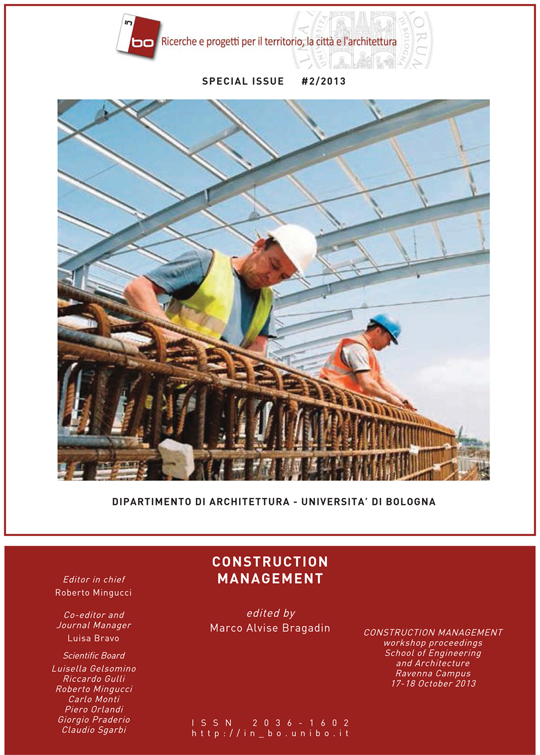REPNET: project scheduling and workflow optimization for Construction Projects
DOI:
https://doi.org/10.6092/issn.2036-1602/4054Keywords:
construction management, project planning, activity network, resource scheduling, location based schedulingAbstract
Project planning and control are core processes for construction management. In practice project planning is achieved by network - based techniques like Precedence Diagramming Method (PDM).Indeed many researchers and practitioners claims that networking techniques as such do not provide a suitable model for construction projects. Construction process modeling should incorporate for specific features of resource flows through project activities. So an improved resource scheduling method for construction is developed, called REPNET, based on a precedence network plotted on a resource–space chart and presented with a flow-line chart. The heuristics of REPNET are used to carry out resource timing while optimizing processes flows and resource usage. The method has been tested on a sample project.
References
Arditi D., Tokdemir O. B., Suh K. (2001) Scheduling System for repetitive unit construction using line-of-balance technology. Engineering, Construction and Architectural Management 8(2), 90 – 103
Arditi D., Tokdemir O. B., Suh K. (2002) Challenges in Line-of-Balance Scheduling. Journal of Construction Engineering and Management, vol 128(6), 545-556
Bragadin M. A. (2008). La programmazione dei lavori con i metodi reticolari. Ed. Maggioli
Bragadin M. A. (2010). Heuristic Repetitive Activity Scheduling Process for Networking Techniques. Proceedings of the CIB 2010 World Building Congress, Salford Quays, U.K. 1-12
Bragadin M., Kähkönen, K (2011). Heuristic Solution for Resource Scheduling for Repetitive Construction
Projects. Proceedings of the MISBE 2011 CIB Congress, Amsterdam, The Netherlands
El Rayes K., Moselhi O. (1998). Resource-driven scheduling of repetitive activities. Construction Management and Economics, 16, 433-446
Harris R. B., Ioannou P. G. (1998). Scheduling Projects with repeating activities. Journal of Construction Engineering and Management, vol 124(4), 269-278
Kähkönen, K. (1994). Interactive Decision Support System for Building Construction Scheduling. Journal of Computing in Civil Engineering, 8(4), pp. 519-535
Kang L.S., Park I.C. and Lee B. H. (2001). Optimal Schedule Planning for Multiple, Repetitive Construction
Process. Journal of Construction Engineering and Management, 127(5), 382-390
Kenley R., Seppänen O. (2009). Location-Based Management for Construction Projects: part of a new Typology for Project Scheduling Methodologies. Proceedings of the 2009 Winter Simulation Conference, 2563-2570
Kenley R., Seppänen O. (2010). Location-Based Management for Construction. Spon Press, U.K
Koskela L. (1992). Application of New Production Philosophy to Construction. CIFE Technical Report #72, Stanford University, USA, September 1992
Lowe, R. H., D’Onofrio, M. F., Fisk, D.M., Seppanen O. (2012). A Comparison of Location - Based Scheduling with the traditional Critical Path Method. 2012 Annual meeting of American College of Construction Lawyers
Märki, F., Fischer, M., Kunz; J. and Haymaker, J. (2007). Decision Making for Schedule Optimization. Stanford University, CIFE Technical Report #169
Moselhi O., Hassanein A. (2004). Discussion of Network Creation and development for Repetitive-Unit Projects. Journal of Construction Engineering and Management, 130(4), 613-614
Selinger S. (1980). Construction planning for linear projects. Journal of Construction Division American Society Civil Engineers, 106(2), 195-205
Steyn H. (2000). An investigation into the fundamentals of critical chain project scheduling International. Journal of Project Management, 19(2000), 363-369
Tommelein I. D., Riley D. R. Howell G.A. (1999). Parade Game: Impact of work flow variability on trade performance. Journal of Construction Engineering and Management, vol. 125, n. 5/1999
Vanhoucke M. (2006). Work Continuity Constraints in Project Scheduling. Journal of Construction Engineering and Management, 132 (1), 14-25
Yang I. T., Ioannou P. G. (2001). Resource-driven scheduling for repetitive projects: a pull-system approach. Proceedings of the 9th International Group for Lean Construction Conference, Singapore, 6-8 August, 365-377
Yi K.J., Lee H. and Choi Y.K. (2002). Network Creation and development for Repetitive-Unit Projects. Journal of Construction Engineering and Management, 128(3), 257-264
Downloads
Published
How to Cite
Issue
Section
License
Copyright (c) 2013 Marco Alvise Bragadin, Kalle Kahkonen
Copyrights and publishing rights of all the texts on this journal belong to the respective authors without restrictions.
This journal is licensed under a Creative Commons Attribution-NonCommercial 4.0 International License (full legal code).
See also our Open Access Policy.
Metadata
All the metadata of the published material is released in the public domain and may be used by anyone free of charge. This includes references.
Metadata — including references — may be re-used in any medium without prior permission for both not-for-profit and for-profit purposes. We kindly ask users to provide a link to the original metadata record.







